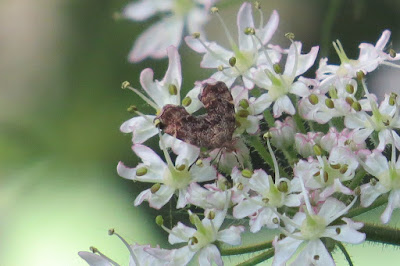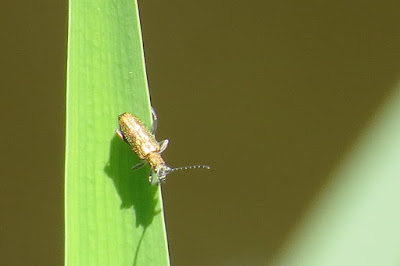Two moths were caught. An uninteresting looking micro-moth was not present in the pot this morning, having presumably crawled out of one of the air-holes.
The second moth looked like some kind of carpet moth, and was still present this morning. Unfortunately it was also dead.
 |
| Yellow-barred Brindle |
I emailed one of my shots to Mike Southall to get a second opinion. He has kindly confirmed my identification of the moth which he records annually in his moth trap, and which the books describe as local.
The day then took an unexpected turn when t'Internet told me that a Corncrake was calling at a site near Alvecote in north Warwickshire. Dave had mentioned the report of this bird yesterday, but I had then learnt it was an "unconfirmed report" which is birder-speak for "thought to be a load of rubbish".
Clearly it was no longer thought of in that way.
I have only ever seen one Corncrake, on Scilly in 1987, and have only ever heard one, in Yorkshire during the 1990's. Records in the West Midlands since I have been birding relate to chance flushings of birds in autumn, so no-one has twitched one since 1972 (pre even me) when one spent a week at Upton Warren.
I made a mental note of where it was supposed to be and set off to twitch it. I no longer own a pager, and also do not own a smart phone (I'm very last century) so I was relying on my mental map based on the Internet report. This nearly led to disaster as I drove the entire length of the road I thought it was audible from without seeing any birders' cars. On the point of giving up I pulled into a lay-by which contained another car. The owner was sitting in it with a couple of small dogs. On his knees was a field guide opened at a page containing the Flycatchers of Europe. I tapped on the window and the gentleman, Roy, told me which road to take.
In no time at all I arrived at a T junction with numerous chaotically parked cars and a group of men standing at a gate. Clearly I had found the right place.
I joined the group, and within five minutes the Corncrake started calling. Crex crex, crex crex. Was a latin name for a bird ever so apt?
I did attempt to record the moment on my camera's video function. You can just hear it crexing above various extraneous noises.
The big issue is can I add it to my W Mids list? There are those who would say a bird must be seen to be tickable. However, I think a special exception should be made for Corncrake, so there!






























